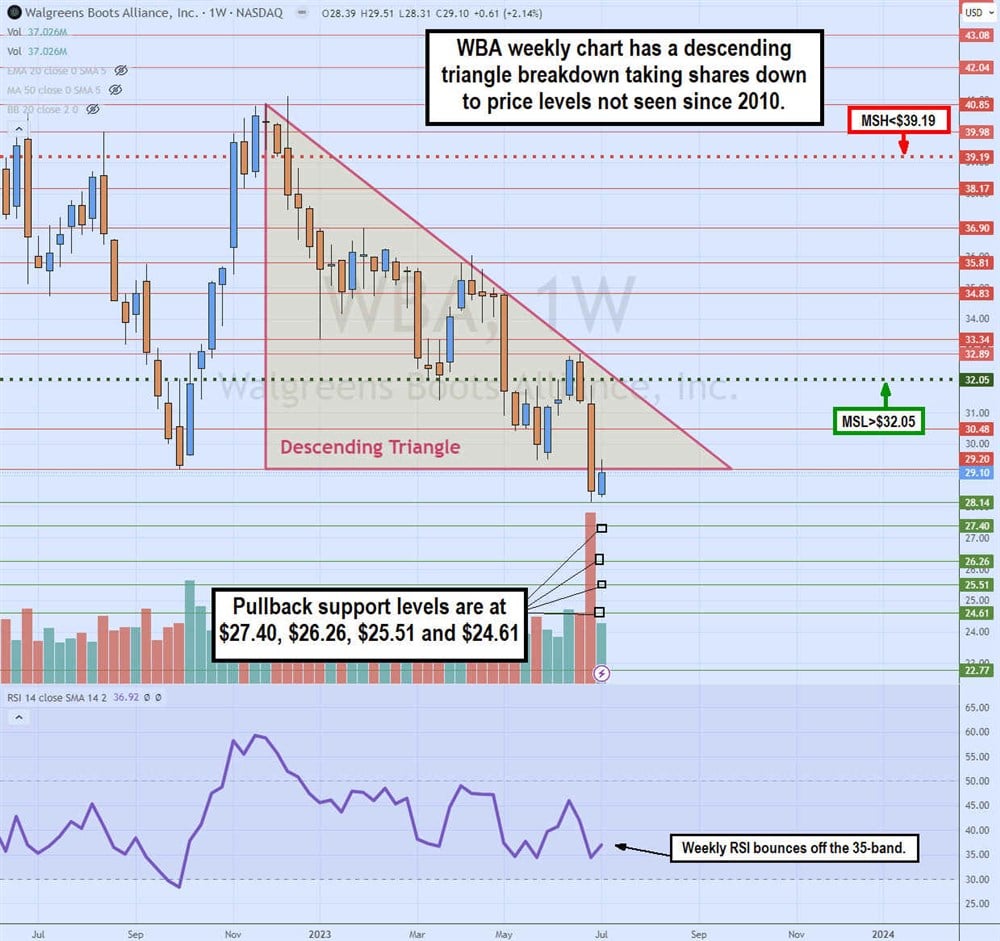
Integrated healthcare and pharmacy retailer Walgreens Boots Alliance Inc. (NYSE: WBA) stock has fallen 21.75% year-to-date (YTD), hitting price levels not seen since 2010.
Walgreens shares have time traveled back 13 years, causing investors to wonder if it's a bargain at just 7x forward earnings with a 6.6% annual dividend — or a value trap. The company was a strong benefactor with COVID testing programs and vaccinations during the pandemic. However, that business segment has dwindled as the pandemic falls further back in the rearview mirror.
Post-pandemic normalization has been continuing for all pharmacy chains. Walmart parlayed its success during the pandemic into its partnership with Village Medical to deliver value-based full primary care healthcare services integrated with Walgreens under one roof. Margins have fallen from inflationary pressures, but this isn't just isolated to Walgreens, as CVS Health Co. (NASDAQ: CVS) and Rite Aid Co. (NASDAQ: RAD) are still experiencing normalization with their brick-and-mortar stores.
Healthcare Growth Engine
Village Medical (VillageMD) acquired Summit Health for $8.9 billion to expand its total locations to over 680. Walgreens has been beefing up its VillageMD footprint, expanding its full-service primary care clinics in the U.S. to over 680 locations, with 200 adjacent to Walgreens U.S. stores. The company had invested $5.1 billion in Village Medical to grow its location to over 30 U.S. markets in 2025 and up to 1,000 locations in 2027. Walgreens owns a 63% stake in VillageMD.
Walgreens estimates that over 75% of Americans reside within five miles of a Walgreens, making for an excellent opportunity to provide full-service primary care offerings to local communities. Walgreens is the first national pharmacy chain to offer full-service primary care practices with primary care physicians co-located with pharmacists under one roof. Unlike CVS Minute Clinics, Walgreens VillageMD offers full-service primary care services. Walgreens also owns Shields Health Solutions and CareCentrix, a home health and hospice services provider.
The Revenue Engine Continues to Grind
On June 27, Walgreens reported its fiscal Q3 2023 earnings report for the quarter ending May 2023. The company reported a non-GAAP earnings per share (EPS) profit of $1, excluding nonrecurring items, versus consensus analyst estimates for a profit of $1.07, a seven-cent beat.
GAAP EPS fell to 14 cents from 20 cents in the year-ago period. Revenues rose 8.6% year-over-year (YoY) to $35.41 billion, beating analyst estimates of $35.23 billion. Revenues were up on a constant currency basis. Walgreen's healthcare assets drove revenue growth contributing $8 billion in sales run-rate in Q3 2023.
CEO Insights
Walgreens CEO Rosalind Brewer noted that the challenging macro environment, significantly lower demand for COVID-related services and the weaker respiratory season contributed to margin pressures in Q3 2023. Its healthcare segment and strength in its U.S. retail pharmacy segment drove the higher-than-expected revenues. The company had a $6.8 billion operating loss in the first nine months of 2023 due to the $6.8 billion pre-tax charge for opioid litigation and claims, which are also being paid by Walmart Inc. (NYSE: WMT) and CVS Health.
Fiscal Full-Year 2023 Guidance
Walgreens expects fiscal full-year fiscal 2023 EPS between $4 to $4.05, down from earlier expectations of $4.45 to $4.65, versus $4.45 consensus analyst estimates. A higher effective tax rate should impact its fourth quarter negatively. Fiscal 2024 preliminary expectations are for growth in the low-to-mid single digits.
The lowered guidance caused shares to collapse to 2010-level prices. Deutsche Bank cut its ratings on WBA to a Hold from Buy with a $34 price target, down from $46. Morgan Stanley reiterated its Underweight rating and lowered its price target to $27 from $37.
Check out Walgreens Boots Alliance analyst ratings and price targets on MarketBeat.

Weekly Descending Triangle Breakdown
The weekly candlestick chart for WBA failed its previous ascending triangle causing it to invert into a descending triangle. The descending triangle commenced in November 2022 after shares hit $40.85. The weekly market structure high (MSH) sell triggered the breakdown through $39.39.
WBA descended, making lower highs on bounces and lower lows on drops. The lower highs formed a descending trendline, while the flat bottom low at $29.20 formed the lower trendline. WBA attempted a market structure low (MSL) breakout through $32.05 in June 2023 but rejected at the descending trendline at $32.89, causing shares to collapse on its lowered earnings guidance through the $29.20 lower flat-bottom trendline to $28.14 as it becomes a resistance level. The weekly RSI is attempting to coil off the 35-band. Pullback support levels are $27.40, $26.26, $25.51 and $24.61.